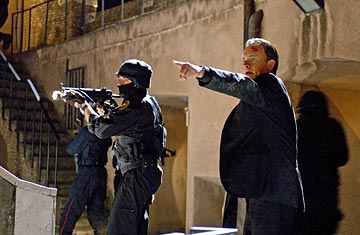
Tom Hanks in Ron Howard's Angels & Demons
Some critics might swat Angels & Demons with tepid adjectives — "bustling" and "fumbling" spring to mind — but the only review that really matters came in last weekend. L'Osservatore Romano, the official newspaper of Vatican City, described this sequel to The Da Vinci Code as "more than two hours of harmless entertainment, which hardly affects the genius and mystery of Christianity" and "a video game that first of all sparks curiosity and is also, maybe, a bit of fun."
A few years back, the Vatican, the seat of power for the Roman Catholic Church, had waxed apoplectic over The Da Vinci Code — both the Dan Brown book and Ron Howard's 2006 movie version. According to the director, the Holy See blocked his attempts to shoot scenes of Angels, another Brown novel, in the Roman churches where much of it is set. So Howard must have found L'Osservatore Romano's genial review an unexpected blessing, somewhere between a celebratory puff of white smoke and the mild penance of 10 Our Fathers and 10 Hail Marys. We also hear that the paper's gossip columnist, Father Guido Sarducci, praised Tom Hanks for looking surprisingly fit in swim trunks. (See Tom Hanks' top 10 hairstyles.)
Beach scenes in a religious thriller? Not quite. World-renowned symbologist Robert Langdon (Hanks) is taking a 5 a.m. water workout in the Harvard swimming pool when a papal emissary shows up to inform him that someone has kidnapped four prominent Cardinals, all in line to be the next Pope, and threatened to murder them and, that very night, blow up St. Peter's Square with a vial of antimatter stolen from a Geneva research lab. In Rome by sundown, Langdon finds adversaries in a stern Cardinal (Armin Mueller-Stahl) and the head of the Vatican's Swiss Guards (Stellan Skarsgard), and two allies in a passionate young Vatican priest (Ewan McGregor) and a scientist (Ayalet Zurer) from the antimatter lab. The meat of the story occupies about five hours that evening, as Langdon rushes from one holy site to another, trying to save lives and solve the big riddle: Who killed the Pope? (See pictures of the Pope in the Holy Land.)
The sense of chronological urgency already makes Angels & Demons an improvement, as a movie scenario, over The Da Vinci Code, however spectacular a publishing success that was. The Da Vinci Code sold more than 60 million copies in 40 languages, graced the New York Times best-seller list for 144 weeks, or nearly three years, and inspired parodies in both hard-core (The Da Vinci Load) and soft-core movies (The Da Vinci Coed). People picked it up and couldn't put it down, in part because it was a very bookish book: an elaborate web of church lore leading to the 2,000-year-old dish that Jesus and Mary Magdalene had been married and their God-woman offspring walked the earth today. To be faithful to the book, Howard and screenwriter Akiva Goldsman had to lard the movie with giant extracts of religious arcana. Cinematically, it was a slog. (Read TIME's review of The Da Vinci Code.)
But it was also the 27th top worldwide grosser in film history, so here comes Angels: same star, director, producer (Brian Grazer) and scripter (abetted this time by David Koepp). Also the same approach: it's a movie, so we'd better feign movement. The back-history in which Langdon is an expert requires Hanks to speak dialogue with its own footnotes, so Howard camouflages the static nature of enterprise by having his star spout arcana while rushing from church to church. In fact, virtually all the actors have to talk the talk while they walk the walk. When they take a breather and stand still, the camera skates 360s around them.
